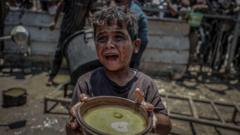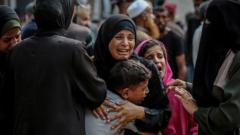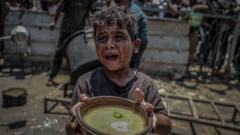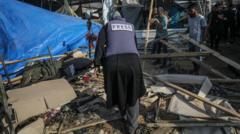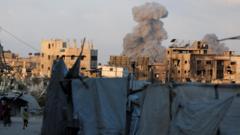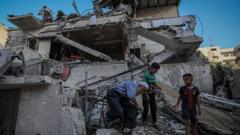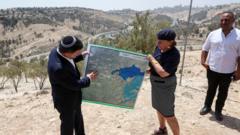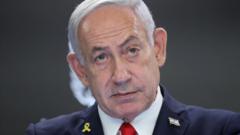A recent report highlights the dire conditions that Palestinians in Gaza are facing, attributed largely to governmental actions and restrictions.
**The Man-Made Catastrophe: Understanding the Famine in Gaza**
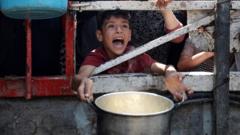
**The Man-Made Catastrophe: Understanding the Famine in Gaza**
As evidence mounts of a famine in Gaza, questions arise about the policies leading to food shortages amid heightening tensions.
In a grave revelation, the Integrated Food Security Phase Classification (IPC), an esteemed hunger monitoring agency supported by the United Nations, insists that a famine is currently ravaging Gaza, attributing its origins to "entirely man-made" factors. The IPC's startling findings suggest that nearly half a million of Gaza’s residents, representing a quarter of the population, are undergoing severe hunger due to systematic obstruction of food supplies by Israeli authorities. This bleak reality contrasts starkly with the reported surplus of humanitarian aid resting just outside Gaza's borders.
The IPC report paints a grim picture of life in Gaza, especially in the Gaza City area. An alarming one-in-five households is reportedly suffering from extreme food shortages, while approximately one-third of children in the region are reported to be acutely malnourished. The mortality figure—a minimum of two out of every 10,000 people dying daily—is particularly concerning, although the actual data may be severely underreported due to collapsed monitoring systems.
Gaza's recent crisis has escalated following an extended blockade that began in March 2025, exacerbated by wartime conditions which began with the Hamas-led attack on Israel in October 2023. Israel's gradual reconsideration of its strict regulations on aid has allowed for limited food supplies to trickle into Gaza, but humanitarian organizations argue that these measures remain inadequate and inefficient in addressing the urgent needs of the population.
As the humanitarian situation spirals downward, food distribution has taken a perilous turn. A new food network overseen by a controversial American organization, the Gaza Humanitarian Foundation (GHF), has replaced the previously UN-managed system, restricting distribution points from 400 to merely four. The grave risks associated with accessing food are evident, as nearly 1,000 Palestinians have died in skirmishes near GHF distribution sites.
International response to the ongoing humanitarian crisis has been vociferous, with UN Secretary General Antonio Guterres and other global leaders condemning the conditions as a violation of international law. Criticism, however, has been met with strong rebuttals from the Israeli government, who assert that the IPC's findings are manipulated to favor Hamas's narrative.
In a potential escalation of the ongoing conflict, Israeli Prime Minister Benjamin Netanyahu has announced the mobilization of thousands of reservists for an invasion of Gaza City, compounding fears of further disruption to an already beleaguered population. A coalition of UN agencies has voiced grave apprehension over this anticipated assault, warning it could result in catastrophic ramifications for civilians struggling to survive the current conditions.
As the situation evolves, the fundamental questions surrounding humanitarian aid access, accountability, and the implications of the ongoing conflict remain front and center in the discourse surrounding Gaza's humanitarian crisis.
The IPC report paints a grim picture of life in Gaza, especially in the Gaza City area. An alarming one-in-five households is reportedly suffering from extreme food shortages, while approximately one-third of children in the region are reported to be acutely malnourished. The mortality figure—a minimum of two out of every 10,000 people dying daily—is particularly concerning, although the actual data may be severely underreported due to collapsed monitoring systems.
Gaza's recent crisis has escalated following an extended blockade that began in March 2025, exacerbated by wartime conditions which began with the Hamas-led attack on Israel in October 2023. Israel's gradual reconsideration of its strict regulations on aid has allowed for limited food supplies to trickle into Gaza, but humanitarian organizations argue that these measures remain inadequate and inefficient in addressing the urgent needs of the population.
As the humanitarian situation spirals downward, food distribution has taken a perilous turn. A new food network overseen by a controversial American organization, the Gaza Humanitarian Foundation (GHF), has replaced the previously UN-managed system, restricting distribution points from 400 to merely four. The grave risks associated with accessing food are evident, as nearly 1,000 Palestinians have died in skirmishes near GHF distribution sites.
International response to the ongoing humanitarian crisis has been vociferous, with UN Secretary General Antonio Guterres and other global leaders condemning the conditions as a violation of international law. Criticism, however, has been met with strong rebuttals from the Israeli government, who assert that the IPC's findings are manipulated to favor Hamas's narrative.
In a potential escalation of the ongoing conflict, Israeli Prime Minister Benjamin Netanyahu has announced the mobilization of thousands of reservists for an invasion of Gaza City, compounding fears of further disruption to an already beleaguered population. A coalition of UN agencies has voiced grave apprehension over this anticipated assault, warning it could result in catastrophic ramifications for civilians struggling to survive the current conditions.
As the situation evolves, the fundamental questions surrounding humanitarian aid access, accountability, and the implications of the ongoing conflict remain front and center in the discourse surrounding Gaza's humanitarian crisis.

